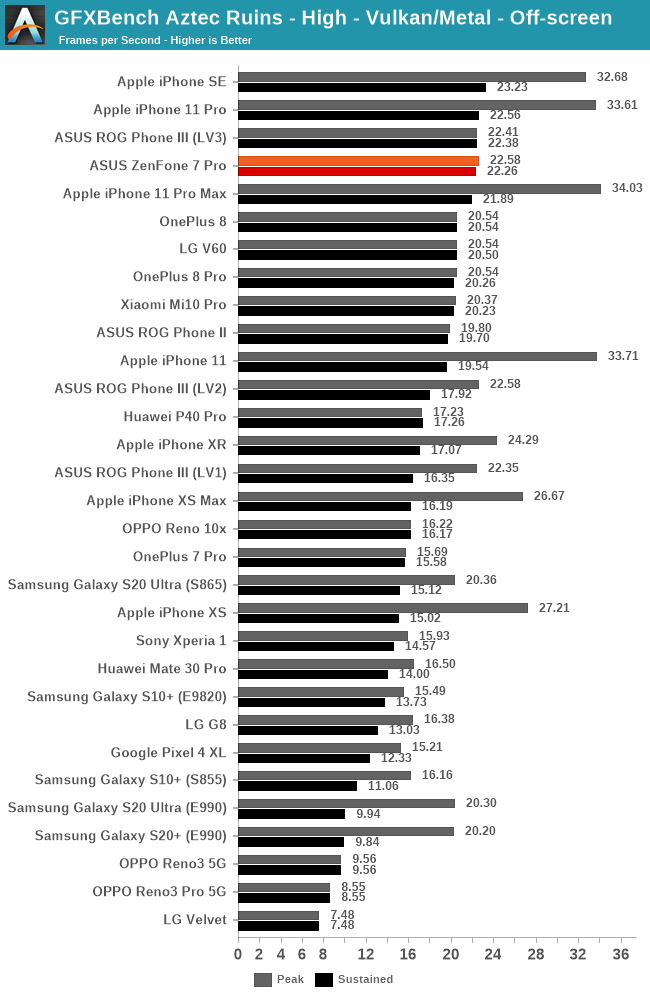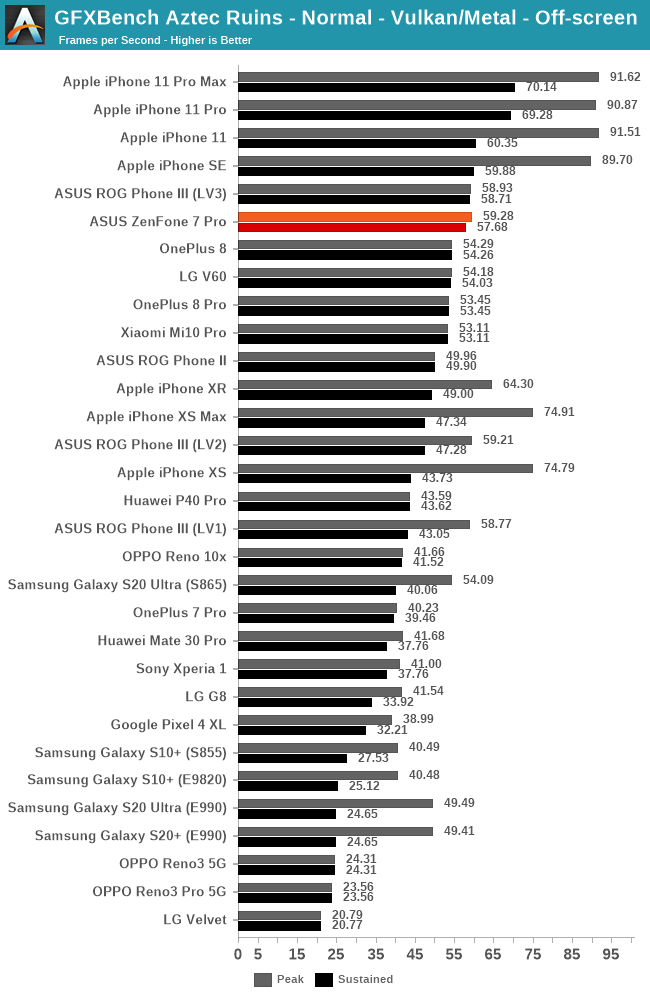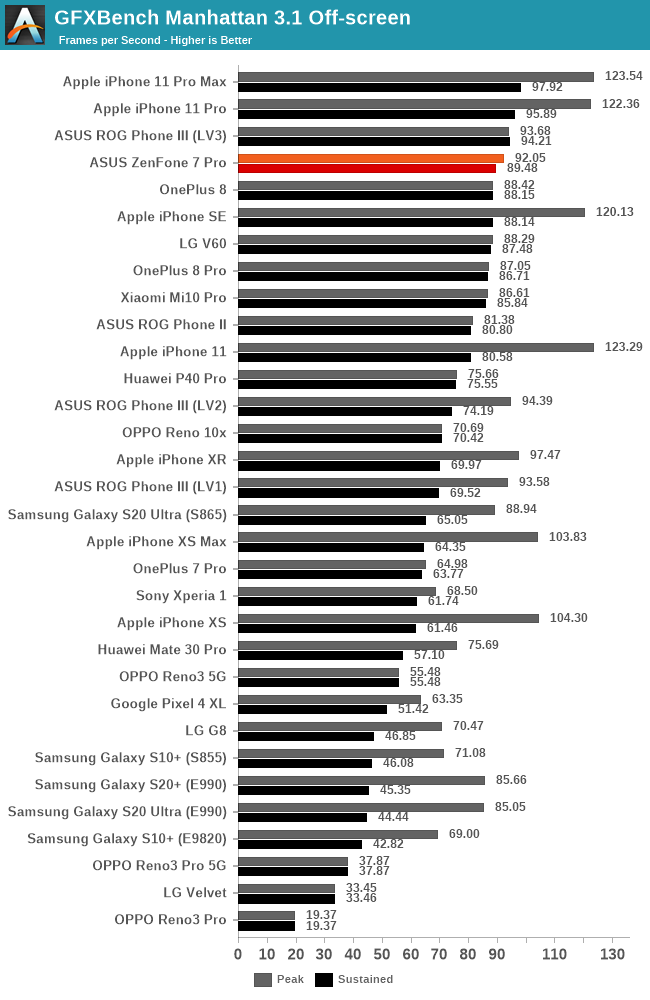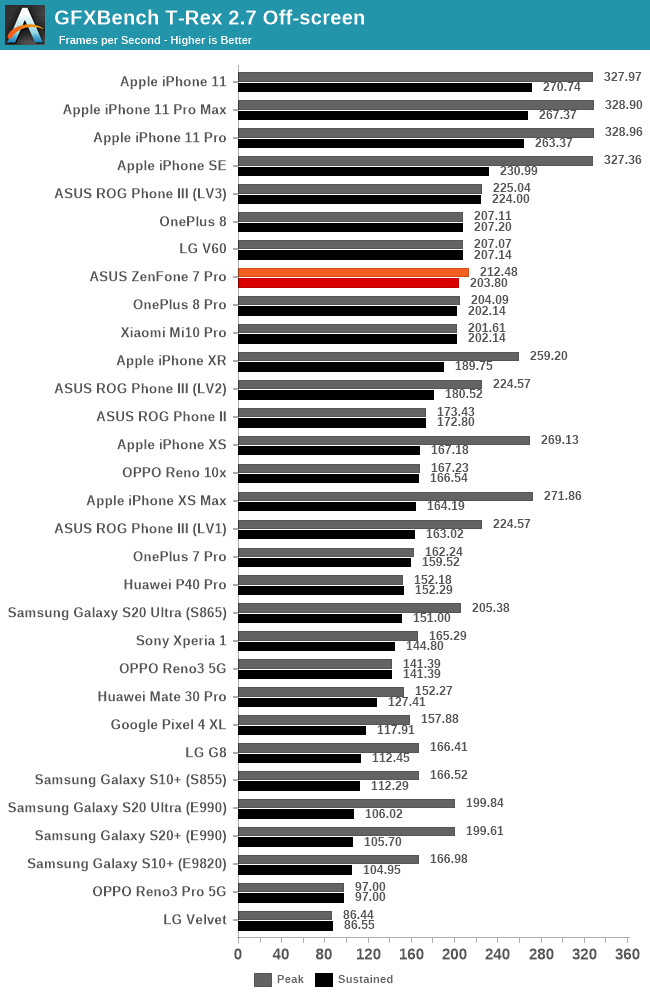The ASUS ZenFone 7 Pro Review: The Triple Flip-Camera
by Andrei Frumusanu on September 1, 2020 3:00 AM EST- Posted in
- Mobile
- Asus
- Smartphones
- ZenFone 7
- ZenFone 7 Pro
GPU Performance
Gaming performance of the ZenFone 7 Pro is also very interesting as it represents a contrasting data-point from the same vendor which also offers a gaming-focused phone such as the ROG Phone III. Both phones also feature the higher performance binned Snapdragon 865+. In the ROG Phone III review we saw somewhat mixed results from the new SoC, so let’s see how the ZenFone fares:

Starting off with Basemark GPU, the ZenFone 7 Pro performs quite excellently in terms of its sustained performance figures, with only a few fps of throttling after prolonged periods.
I’ve noted that the phone’s peak skin temperature reached 44°C, which is still reasonable. In essence, it reaches about the same thermal levels as the ROG Phone III when that phone is set to its “Level 2 X-Mode”.




The rest of the GFXBench tests all showcased similar peak and sustained performance figures, strongly favouring the ZenFone 7 Pro.
Frankly speaking this is both a win for ASUS as the ZenFone 7 Pro performs very well, and sort of a self-goal, given that it essentially invalidates performance advantage aspect of the ROG Phone III.
As to why there’s such a stark difference between the two phones, I’m not too sure, however the two devices have quite different motherboard layouts. The ROG Phone III has the SoC placed on a rather narrow motherboard to the side of the phone near the accessory USB-C ports, whilst the ZenFone 7 has it located on a bigger PCB that covers the top part of the phone underneath the cameras. It’s possible that this simple location change allows for better heat dissipation on the ZenFone 7 Pro as the SoC is more centrally located inside the phone, thus making usage of more of the screen as a dissipation area.










31 Comments
View All Comments
GC2:CS - Tuesday, September 1, 2020 - link
I find the battery lifespan saving max charge limit comparison somewhat dishonest.For the same usage you need 500 cycles at 80 and just 400 if you charge to 100. So it is more like 7 and 12% degradation.
I think limiting charge might be usefull for things like headphones. They just sit for days in their case charged to 100%.
Also I am quite woried where we are going with battery capacities. Looks like even 4000+ mAh is not a guarantee of great battery life these days.
CampGareth - Tuesday, September 1, 2020 - link
That's assuming you drop to 0% charge every single time, under that usage you're going to burn through batteries regardless. The state of charge limit is intended more for folks that stay at a high charge percentage. I can't remember the last time my phone dropped below 60%, it's on charge at home and at work so spends a lot of time sitting at 100% charge which degrades the battery faster even when it's idle.imoc - Tuesday, September 1, 2020 - link
Not true. Their graph states SoC(State of charge) and charge cycle doesn't mean Any%-80%, a full 100% battery top up counts as one(such as 30-80 two times).close - Tuesday, September 1, 2020 - link
There are a few trends to dislike, small batteries for the consumers attached to the phone (mega SoCs, gazillion Hz screens, all of the Gs, all the time), glass backs especially when not actually needing it, removing the headphone jack even on phones that are clearly big enough to fit one, etc. This phone ticks most of them.SirDragonClaw - Tuesday, September 1, 2020 - link
You need to learn how modern batteries work...huyhung411991 - Tuesday, September 1, 2020 - link
First paragraph in Battery Life section is repeated.Ryan Smith - Tuesday, September 1, 2020 - link
Thanks!linuxgeex - Tuesday, September 1, 2020 - link
Before I even look at image quality with video recording, I pay attention to the background noise. You should be able to tap the screen, adjust volume up and down, power the screen on and off, and walk in light wind without hearing distracting sounds. This camera failed this basic requirement with flying colours lol.Kangal - Tuesday, September 1, 2020 - link
Dunno, it's hard to judge the quality without a reference.The photo, video, microphone comparisons should have something like a Sony A7 + Lav, as that's basically professional quality, and it would be much easier to spot where phone's deficiencies lay.
Bonus points should be made to compare all devices on a quick Auto Mode, but Manual-Professional Adjustment on the Mirrorless. That's the most important comparison. And do it in Good Lighting, Overcast, and Low-light conditions. And do it in Macro, Regular, and Zoom modes.
Manual Modes are interesting on the new Sony Xperia 1 ii Pro, and LG V60... but are somewhat gimmicky. Phones are meant for quick "point and shoot", for professional quality you can't subsidise a phone with manual mode for a proper DSLR or Mirrorless. It would be like trying to use a hot-hatch to move heavy loads, then complaining, instead of using a pickup truck.
linuxgeex - Tuesday, September 1, 2020 - link
@Andrei - several of the camera comparison photos are missing and some are backwards.